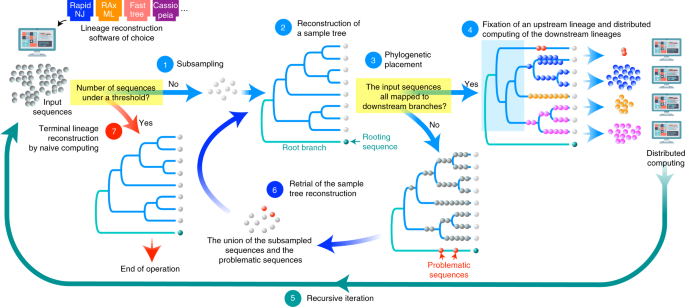The U.S. National Science Foundation announced the first-ever Enabling Partnerships to Increase Innovation Capacity (EPIIC) investment of $19.6 million to nearly 50 teams at U.S. institutions of higher education, including teams from historically Black colleges and universities, minority-serving institutions and community colleges. Each institution will receive up to $400,000 over three years.
Through this investment, EPIIC awardees will receive support to develop capacity and institutional knowledge to help them build new partnerships, secure future external funding and tap into their regional innovation ecosystems — potentially into an NSF Regional Innovation Engine (NSF Engine) or an Economic Development Administration Regional Technology and Innovation Hub (EDA Tech Hub). NSF also recently released the next funding opportunity for EPIIC. Learn more at an informational webinar on Oct. 25 at 3:30 p.m. ET.
“NSF aspires to accelerate the nation’s research and innovation enterprise and empower all Americans to participate in the science- and technology-driven workforce,” said Erwin Gianchandani, NSF assistant director for Technology, Innovation and Partnerships (TIP). “EPIIC reinforces NSF’s commitment to develop new, inclusive innovation ecosystems by connecting diverse networks of partners to work together to drive the expansion of key technologies — and the technology workforce — in the U.S. and in turn address pressing national, societal and geostrategic challenges.”
Launched by the TIP Directorate, EPIIC works with institutions interested in growing external partnerships and building innovation capacity. NSF recognizes that many institutions, including MSIs, small academic institutions and two-year institutions, stand to benefit from additional focused support for the infrastructure and resources needed to grow external partnerships and to tap into innovation ecosystems, including engaging with NSF Engines and EDA Tech Hubs.
“NSF recognizes that institutions with limited research capacities require comprehensive support to become equitable partners in their regional innovation ecosystems,” said Thyaga Nandagopal, director of TIP’s Division of Innovation and Technology Ecosystems. “This funding aims to set EPIIC awardees on level ground to seek and build lasting partnerships to tap into their innovation potential, and the capacity-building efforts will continue to provide significant innovation partnership opportunities well into the future.”
EPIIC awardees
Awardees are listed in alphabetical order by institution name. The full award list can be found on NSF’s award search webpage.
- Albany College of Pharmacy and Health Sciences: Collaborative Research: EPIIC: EmpowerEd — Building the Future Workforce Together (NSF Award 2331557).
- Alvernia University: Collaborative Research: Research Infrastructure: EPIIC: Collaborative Proposal: LIGHT UP: Leveraging Innovation to Grow High Tech and University Partnerships (NSF Award 2331571).
- Angelo State University: Collaborative Research: EPIIC: Raising Rural Economic Development & Innovation (RREDI) (NSF Award 2331473).
- Benedict College: Collaborative Research: EPIIC: Developing an Eco Engine Jumpstart Kit (NSF Award 2331632).
- Benjamin Franklin Cummings Institute of Technology: Collaborative Research: EPIIC: EmpowerEd — Building the Future Workforce Together (NSF Award 2331559).
- Bowie State University: Collaborative Research: Research Infrastructure: EPIIC: Collaborative Proposal: LIGHT UP: Leveraging Innovation to Grow High Tech and University Partnerships (NSF Award 2331573).
- Champlain College: Collaborative Research: EPIIC: Developing Emerging Technology Ecosystem Partnerships for Primarily Undergraduate Institutions (NSF Award 2331431).
- Christopher Newport University: Collaborative Research: EPIIC: Developing Emerging Technology Ecosystem Partnerships for Primarily Undergraduate Institutions (NSF Award 2331430).
- College of Southern Nevada: Collaborative Research: EPIIC: Cultivating Innovation and Research Capacity for Life Sustaining Emerging Technologies (CIRCLET) (NSF Award 2332943).
- Richard Bland College of William & Mary: Collaborative Research: EPIIC: Raising Rural Economic Development & Innovation (RREDI) (NSF Award 2331475).
- Columbus State Community College: Collaborative Research: EPIIC: Expanding Team Capacity for High Impact and New Growth (ETCHING) Cohort (NSF Award 2331216).
- Coppin State University: Collaborative Research: Research Infrastructure: EPIIC: HBCU Alliance for Strategic Partnerships for Innovation and Research Enhancement (HBCU-ASPIRE) (NSF Award 2332022).
- Florida Memorial University: Collaborative Research: Research Infrastructure: EPIIC: HBCU Alliance for Strategic Partnerships for Innovation and Research Enhancement (HBCU-ASPIRE) (NSF Award 2332021).
- Harris-Stowe State University: Collaborative Research: Research Infrastructure: EPIIC: HBCU Alliance for Strategic Partnerships for Innovation and Research Enhancement (HBCU-ASPIRE) (NSF Award 2332024).
- Hobart and William Smith Colleges: Collaborative Research: EPIIC: EmpowerEd — Building the Future Workforce Together (NSF Award 2331555).
- Humboldt State University Foundation: Collaborative Research: EPIIC: Increasing our Innovation SCOREs: Symbiotic Collaboration of Regional Ecosystems (NSF Award 2331550).
- Independence Community College: Collaborative Research: EPIIC: Raising Rural Economic Development & Innovation (RREDI) (NSF Award 2331474).
- Ivy Tech Community College of Indiana: Collaborative Research: EPIIC: Generating Regional Innovative Partnerships (GRIP) (NSF Award 2331586).
- Jefferson College: Collaborative Research: EPIIC: Colleges Aligning Resources to Elevate Education and Regional STEM (CAREERS) Workforce (NSF Award 2331703).
- Kean University: Collaborative Research: Research Infrastructure: EPIIC: Collaborative Proposal: LIGHT UP: Leveraging Innovation to Grow High Tech and University Partnerships (NSF Award 2331572).
- Kentucky Community & Technical College System: Collaborative Research: EPIIC: Developing an Eco Engine Jumpstart Kit (NSF Award 2331631).
- Kentucky State University: Collaborative Research: Research Infrastructure: EPIIC: HBCU Alliance for Strategic Partnerships for Innovation and Research Enhancement (HBCU-ASPIRE) (NSF Award 2332023).
- Kettering University: Collaborative Research: EPIIC: Enabling Meaningful External Research Growth in Emergent Technologies (EMERGE) (NSF Award 2331219).
- Longwood University: Collaborative Research: EPIIC: Raising Rural Economic Development & Innovation (RREDI) (NSF Award 2331472).
- Marymount University: Collaborative Research: Research Infrastructure: EPIIC: Collaborative Proposal: LIGHT UP: Leveraging Innovation to Grow High Tech and University Partnerships (NSF Award 2331570).
- Mississippi Gulf Coast Community College: Collaborative Research: EPIIC: Generating Regional Innovative Partnerships (GRIP) (NSF Award 2331583).
- Montgomery College: Collaborative Research: EPIIC: EmpowerEd — Building the Future Workforce Together (NSF Award 2331558).
- Northern Marianas College: Collaborative Research: EPIIC: Cultivating Innovation and Research Capacity for Life Sustaining Emerging Technologies (CIRCLET) (NSF Award 2332944).
- Ohio Wesleyan University: Collaborative Research: EPIIC: EmpowerEd — Building the Future Workforce Together (NSF Award 2331560).
- Ohlone Community College District: Collaborative Research: EPIIC: Colleges Aligning Resources to Elevate Education and Regional STEM (CAREERS) Workforce (NSF Award 2331704).
- Rose State College: Collaborative Research: EPIIC: Developing an Eco Engine Jumpstart Kit (NSF Award 2331633).
- Rowan College of Burlington County: Collaborative Research: Research Infrastructure: EPIIC: Collaborative Proposal: LIGHT UP: Leveraging Innovation to Grow High Tech and University Partnerships (NSF Award 2331569).
- Saint Francis University: Collaborative Research: EPIIC: Increasing our Innovation SCOREs: Symbiotic Collaboration of Regional Ecosystems (NSF Award 2331551).
- Saint Mary’s University of Minnesota: Collaborative Research: EPIIC: Increasing our Innovation SCOREs: Symbiotic Collaboration of Regional Ecosystems (NSF Award 2331553).
- Seattle University: Collaborative Research: EPIIC: Increasing our Innovation SCOREs: Symbiotic Collaboration of Regional Ecosystems (NSF Award 2331549), with a sub-award to Utah Tech University.
- State University of New York College of Technology at Canton: Collaborative Research: Research Infrastructure: EPIIC: Collaborative Proposal: LIGHT UP: Leveraging Innovation to Grow High Tech and University Partnerships (NSF Award 2331568).
- SUNY Onondaga Community College: Collaborative Research: EPIIC: Expanding Team Capacity for High Impact and New Growth (ETCHING) Cohort (NSF Award 2331217).
- The College of New Jersey: Collaborative Research: EPIIC: Managing Culture Change on Two Fronts: Strengthening Our Capacity to Develop Partnerships (NSF Award 2331372).
- University of Hawaii: Collaborative Research: EPIIC: Cultivating Innovation and Research Capacity for Life Sustaining Emerging Technologies (CIRCLET) (NSF Award 2332942).
- University of Maine Farmington: Collaborative Research: EPIIC: EmpowerEd — Building the Future Workforce Together (NSF Award 2331556).
- University of Northern Colorado: Collaborative Research: EPIIC: Enabling Meaningful External Research Growth in Emergent Technologies (EMERGE) (NSF Award 2331221).
- University of the Incarnate Word: Collaborative Research: EPIIC: Enabling Meaningful External Research Growth in Emergent Technologies (EMERGE) (NSF Award 2331218).
- University of Wisconsin-Eau Claire: Collaborative Research: EPIIC: Managing Culture Change on Two Fronts: Strengthening Our Capacity to Develop Partnerships (NSF Award 2331373).
- Washburn University of Topeka: Collaborative Research: EPIIC: Generating Regional Innovative Partnerships (GRIP) (NSF Award 2331584).
- Western Carolina University: Collaborative Research: EPIIC: Enabling Meaningful External Research Growth in Emergent Technologies (EMERGE) (NSF Award 2331220).
- Wichita State University Campus of Applied Sciences & Technology: Collaborative Research: EPIIC: Generating Regional Innovative Partnerships (GRIP) (NSF Award 2331585).
- William Rainey Harper College: Collaborative Research: EPIIC: Generating Regional Innovative Partnerships (GRIP) (NSF Award 2331582).
Note: This article have been indexed to our site. We do not claim legitimacy, ownership or copyright of any of the content above. To see the article at original source Click Here













